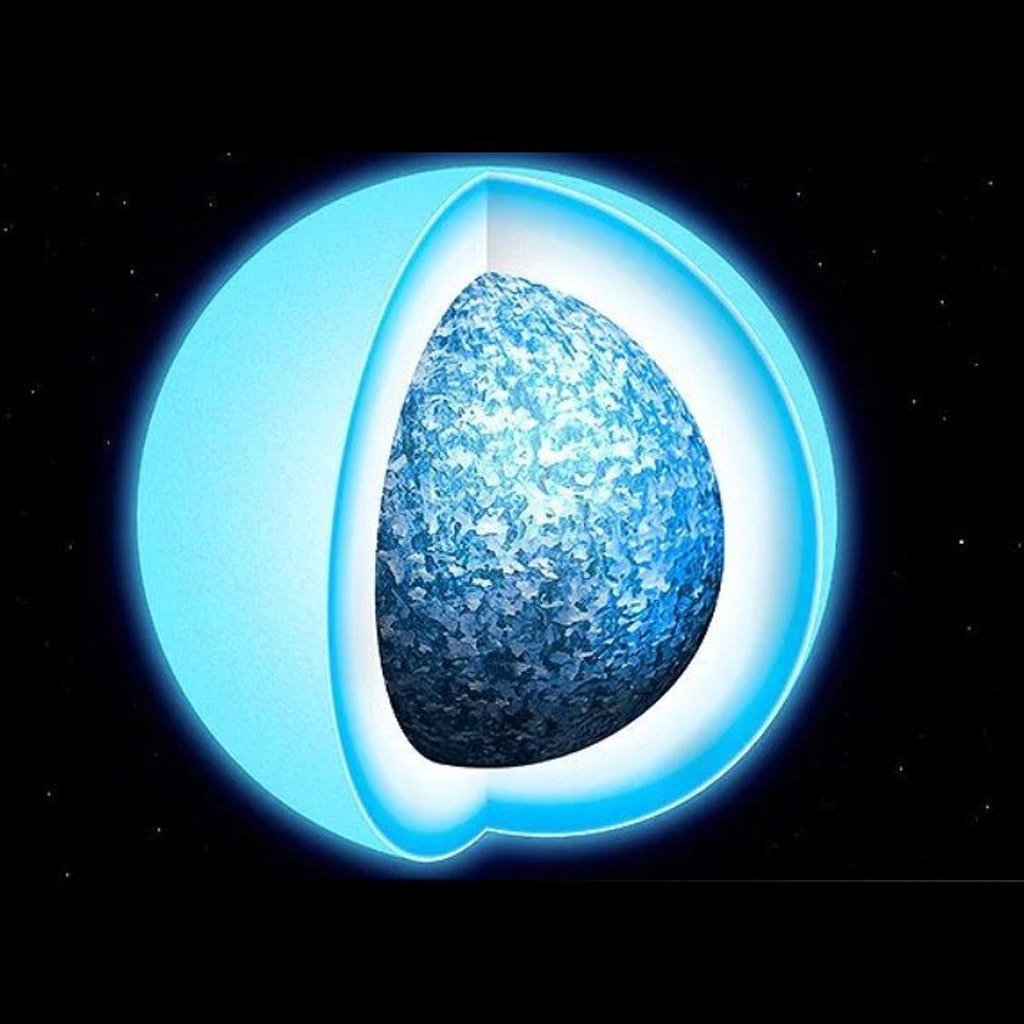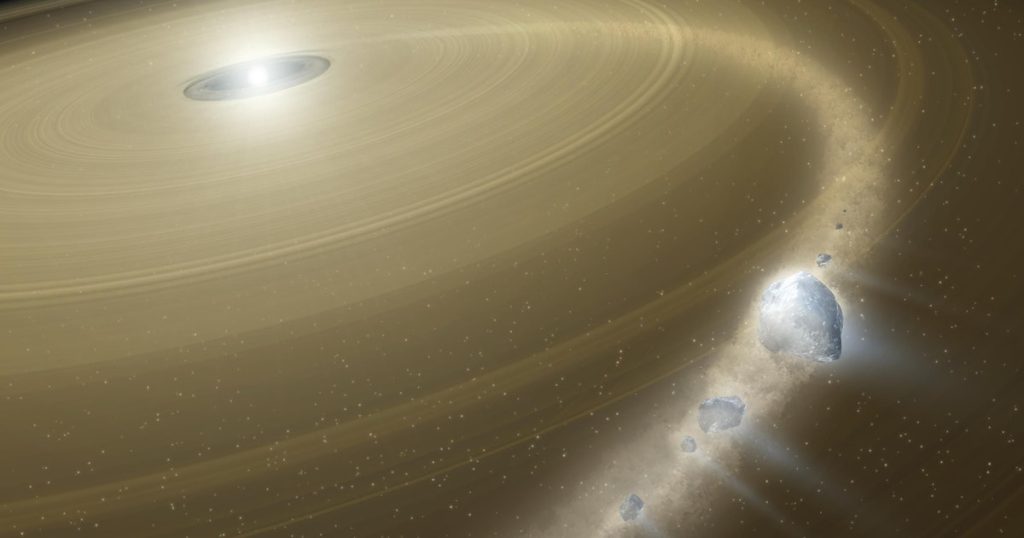Berlin – For the first time, astronomers have directly observed how a star at the end of its life devours planetary debris. Before that, the planets – perhaps only one – had come close to their dying star and were torn apart by their immense gravity. Its debris is now spinning around in a disk of rock.
The star with the designation G29-38 is only 44 light-years away from us, and it is called a white dwarf. This is what astronomers call the burning, extremely dense core of a star similar to our Sun. In fact, it’s the star’s fusion furnace, which has shrunk to the size of Earth, as the nuclear fires quenched. But the stellar remnant is still so hot that it appears as a hot white star in the night sky, hence the name.
So will the earth perish in the fiery furnace of the sun
Using NASA’s Chandra X-ray Telescope, the research team from the University of Warwick in the UK was able to determine the chemical signatures of elements in the spectrum of stellar remnants, which are mainly found in rocky planets. In addition, X-ray flares emitted by the white dwarf, caused by the collision of planetary debris, revealed the stellar meal of the cannibals. The researchers estimated that about 1,600 tons of rock fall on the star every second. who published their discovery in the scientific journal Nature. Researchers say the drama currently unfolding in our cosmic neighborhood could be a harbinger of the fate of our solar system, albeit in the distant future.
Astronomers’ models assume that our sun will use up its hydrogen nuclear fuel in about seven billion years. Then the nuclear fusion recedes in its center. The external pressure of the radiation is no longer sufficient to bear the weight of the star. As a result, the sun’s gas layers expand; This allows her to establish a new balance.
The Sun will become a super-hot giant star that will swallow up the inner planets Mercury and Venus. In angry volcanic eruptions, it repeatedly throws bits of its gaseous envelope into space, only to inflate again afterwards. During this unstable phase, the Sun loses nearly half of its mass. Because this also reduces their gravity, the Earth’s orbit and the orbits of the other planets move significantly outward. The effect bolstered hopes for a long time that the Earth could escape the sun’s fiery breath. However, recent calculations show that the Earth will also set in the sun’s fiery furnace.
In a billion and a half years, the oceans will evaporate
Astrobiologist Jack O’Malley James of the Carl Sagan Institute at Cornell University in the USA and his team have calculated how the aging Sun will change Earth and life on our planet. “In about 600 million years, Earth can no longer be a green planet,” says the researcher. As the sun consumes more and more of its hydrogen supply, the pressure within it increases; It gets hotter and brighter. As a result, forests die on the ground, steppes and deserts expand. Keep in mind: This is about astronomical events, not terrestrial processes like climate change.
“The biodiversity of the plant world is deteriorating; only species that are tolerant of drought, nutrient deprivation and heat survive,” says O’Malley James. The dying off of vegetation slows photosynthesis. The oxygen content in the Earth’s atmosphere is decreasing and the ozone layer that feeds it, which protects living organisms from the sun’s harmful ultraviolet rays, is getting thinner and thinner.
Within a billion years, a critical threshold will be reached, the temperature on the Earth’s surface will reach an average temperature of 50 degrees. “Earth’s food chains are collapsing, and complex life forms are dying out,” says O’Malley James. The primitive life that was still present retreated to the oceans from the increasing heat of the sun, but soon it no longer offered any protection.
In a billion and a half years at the latest, the ocean waters will evaporate because temperatures at the Earth’s surface will rise above the boiling point. Water molecules accumulate first in the Earth’s atmosphere, where they increase the greenhouse effect and lead to higher temperatures. Intense radiation from the sun breaks up water molecules and their atoms escape into space. In this way, the Earth eventually loses all of its water and its entire atmosphere.
The livable area can migrate abroad
Earth’s increasing temperatures are eventually softening rocks. Since there is no water as a lubricant, the drift of the continents stops. Earth has become the planet of Hell and is similar to Venus today.
In five billion years, the Sun will be twice as bright as today and one and a half times as bright. Its outer layers continue to expand and cool. At about 3000 degrees, it’s about half the temperature today. The sun turns into a red giant, a puffy, heat-filled ball of gas on the verge of collapse.
Pr3t3nd3r / iStock
red giant
In seven billion years – then the solar system will be about 11.5 billion years old – the struggle for survival on the inner planets will begin. As the sun was dying, a powerful stream of particles started, causing it to lose about half its mass. Because this also reduces their gravity, the orbits of the planets move outward. Then the Earth moved its orbit at the level of the orbit of Mars today. The orbits of the inner planets Mercury and Venus move outward as well, but not enough to escape the grip of the enlarged Sun. Both planets are devoured by the sun.
The layers of gas in the Sun will reach farther than previously thought. This is evidenced by extensive recent calculations by astronomer Robert Smith of the University of Sussex in Britain and his colleague Klaus-Peter Schroeder of the Mexican University of Guanajuato. The Earth initially rotates within the thin outer layers and is heated to the point of magma. Eventually, the sun picks it up and evaporates it.
“Our planet ends in hell. It does not necessarily mean the end of life in the solar system,” says Smith. As the calculations show, the region in the Solar System that still allows for life-friendly conditions has migrated to the region of gaseous planets with distant orbits. Worlds still frozen today, like Jupiter’s moon Europa, which is suspected of having an ocean of water under its icy shell, or Saturn’s moon Titan, with its seas of liquid hydrocarbons, could seize their chance.
The sun turns into a diamond star
The final chapter will begin in eight billion years, when the Sun will be twelve and a half billion years old. It dumped all its layers of gas, which now escapes into space and lights up to form a colorful glowing gas nebula. The Sun’s core has shrunk to a white dwarf, where carbon mainly accumulates as ash from nuclear fusion. However, she and billions of fellow travelers from Sun-like stars in the Milky Way have a truly bright future ahead.

University of Warwick / Mark Garlick
Diamond star: Researchers say the Sun will one day become a crystal ball.
Even in the slow cooling core of a dying star like the Sun, it can still generate energy that keeps it glowing for billions of years. When a substance hardens and takes on a regular structure, it emits heat. A crystal is formed from carbon – the sun becomes a diamond.
Astronomers have already discovered such diamond stars, including in our cosmic neighborhood. One of the closest of these strange stellar remnants is a white dwarf called BPM 37093, only 50 light-years away. Astronomers nicknamed her “Lucy” after the Beatles song “Lucy in the Sky with Diamonds”. About twice the size of our moon, the stellar remnant consists of a crystal that weighs hundreds of millions of times the weight of the satellite. It is arguably the largest diamond in the local universe. It will shine for trillions of years before it cools down to cool off into space – a diamond almost forever.

“Total coffee aficionado. Travel buff. Music ninja. Bacon nerd. Beeraholic.”







More Stories
The tumor can penetrate the outer skin
We will tell you the real reason for this physical phenomenon that caused the failure of Isaac Newton
A mysterious discovery on Mars – NASA team talks about “tire tracks” or “dragon scales”